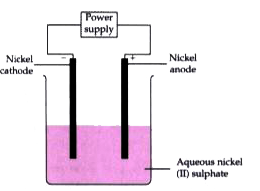During the electrolysis of copper (II) sulphate solution using platinum as cathode and carbon as anode :
What do you observe at the cathode and at the anode?
Step-by-Step Solution:
1. Understanding Electrolysis: Electrolysis is a process that uses electric current to drive a non-spontaneous chemical reaction. In this case, we are focusing on the electrolysis of copper (II) sulfate solution.
2. Identifying the Electrodes: In this scenario, platinum is used as the cathode (negative electrode) and carbon is used as the anode (positive electrode).
3. Reactions at the Cathode:
- At the cathode, copper ions (Cu²⁺) from the copper (II) sulfate solution gain electrons (reduction process).
- The half-reaction can be written as:
Cu2++2e−→Cu
- This means that copper ions are reduced to form solid copper, which gets deposited on the cathode.
4. Reactions at the Anode:
- At the anode, hydroxide ions (OH⁻) present in the solution are oxidized to produce oxygen gas and water.
- The half-reaction can be written as:
4OH−→O2+2H2O+4e−
- This indicates that oxygen gas is released at the anode while water is also produced.
5. Observations:
- At the Cathode: Copper metal is deposited as a solid.
- At the Anode: Oxygen gas is evolved (bubbles of gas can be observed).
Final Answer:
- At the cathode, copper is deposited.
- At the anode, oxygen gas is evolved.
- At the cathode, copper ions (Cu²⁺) from the copper (II) sulfate solution gain electrons (reduction process).
- The half-reaction can be written as:
Cu2++2e−→Cu
- This means that copper ions are reduced to form solid copper, which gets deposited on the cathode.
- At the anode, hydroxide ions (OH⁻) present in the solution are oxidized to produce oxygen gas and water.
- The half-reaction can be written as:
4OH−→O2+2H2O+4e−
- This indicates that oxygen gas is released at the anode while water is also produced.
- At the Cathode: Copper metal is deposited as a solid.
- At the Anode: Oxygen gas is evolved (bubbles of gas can be observed).
- At the cathode, copper is deposited.
- At the anode, oxygen gas is evolved.
Topper's Solved these Questions
- ELECTROLYSISBOOK - ICSECHAPTER - ELECTROLYSISEXERCISE - Additional questions
22 Videos
- ELECTROLYSISBOOK - ICSECHAPTER - ELECTROLYSISEXERCISE - Unit Test Paper 5 - Electrolysis
18 Videos
- ELECTROLYSISBOOK - ICSECHAPTER - ELECTROLYSISEXERCISE - ADDITIONAL QUESTIONS FOR PRACTICE
49 Videos
- CHEMISTRY-2015BOOK - ICSECHAPTER - CHEMISTRY-2015EXERCISE - SECTION-II (40 Marks) Attempt any four questions from this Section.
49 Videos
- METALLURGYBOOK - ICSECHAPTER - METALLURGYEXERCISE - UNIT TEST PAPER 6 - Metallurgy (Select the correct answer from the list A,B,C & given in each statement.)
5 Videos
Similar Questions
During the electrolysis of copper (II) sulphate solution using platinum as cathode and carbon as anode :
Write the reactions at the cathode and at the anode.
View SolutionDuring the electrolysis of copper (II) sulphate solution using platinum as cathode and carbon as anode :
What change is noticed in the electrolyte?
View SolutionWhat would you observe at the (a) cathode (b) anode ?
View SolutionWhat change is noticed in the electrolyte ?During the electrolysis of copper (II) sulphate solution using platinum as cathode and carbon as anode:
View SolutionSelect the correct answer from the choice given in brackets :
The type of reaction at the anode during electrolysis of copper (II) sulphate solution using copper or platinum cathode & carbon anode. [reduction, oxidation, redox]
View SolutionThe ion which is discharged at the anode during the electrolysis of copper sulphate solution using platinum electrode as anode and cathode [Cu2+OH−,SO2−4H+]
View SolutionThe following questions refer to the electrolysis of copper sulphate solution using copper electrodes .
Compare the change in the mass of the cathode with the change in the mass of the anode .
View SolutionDuring the electrolysis of a dilute solution of sulphuric acid, what substance is produced at the anode?
View SolutionWhat is seen to happen to the colour of the copper sulphate solution if platinum electrodes are used ? Explain this observation .
View SolutionAn aqueous solution of nickel (II) sulphate was electrolyzed using nickel electrodes. Observe the diagram and answer the questions that follow

What do you observe at the cathode and anode respectively?
View Solution
